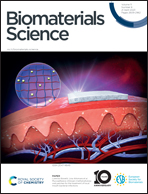Superior biocompatible carbon dots for dynamic fluorescence imaging of nucleoli in living cells†
Abstract
The nucleolus is a newly developed and promising target for cancer diagnosis and therapy, and its imaging is extremely significant for fundamental research and clinical applications. The unique feature, i.e., high resolution at the subcellular level, makes the fluorescence imaging method a powerful tool for nucleolus imaging. However, the fluorescence imaging of nucleoli in living cells is restricted by the limited availability of fluorescent agents with specific nucleolus-targeting capability and superior biocompatibility. Here, promising carbon dots (CDs) with intrinsic nucleolus-targeting capability were synthesized, characterized and employed for dynamic fluorescence imaging of nucleoli in living cells. The CDs exhibit a high fluorescence quantum yield of 0.2, excellent specificity and photostability, and superior biocompatibility, which were systematically demonstrated at the gene, cellular and animal levels and confirmed by their biological effects on embryonic development. All these features enabled CDs to light up the nucleoli for a long time with a high signal-to-noise ratio in living cells and monitor the nucleolar dynamics of malignant cells in camptothecin (CPT) based chemotherapy. Their excellent optical and biological features as well as general nucleolus-targeting capability endow CDs with great potential for future translational research.



 Please wait while we load your content...
Please wait while we load your content...